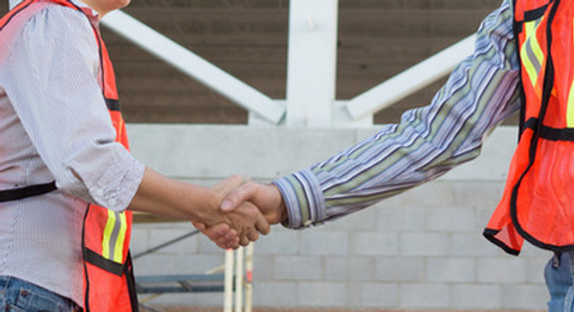Construction projects can be a thrilling and challenging endeavour, but what happens when the hammering and sawing come to a halt?
Closing out a construction project can seem like a daunting task, but with the right approach, it can be a seamless process. As a contractor, you want to make sure that the project is closed out efficiently and effectively, and that the client is completely satisfied with the work. Whether you're wrapping up your first project or closing out your hundredth, the key is to be prepared and to know what to expect.
In this blog, we'll dive into the best practices for closing out a construction project and share some tips and tricks that every contractor should know. From understanding the requirements to performing a final walk-through, we'll cover everything you need to know to close out your project with confidence.
1. Understand the requirements.
Before closing out a project, it's essential to understand the specific requirements and expectations of the owner or client. This includes understanding any outstanding punch list items, final inspections, and any warranties or guarantees that need to be provided. The project scope documents, such as the project charter, project scope statement, and work breakdown structure, play a critical role in understanding the requirements and expectations of the project.

These documents provide a detailed description of the project's objectives, deliverables, and constraints, and they should be reviewed and understood before closing out the project. By understanding the project scope documents, you will be able to identify any outstanding items or concerns that need to be addressed before closing out the project.
It's important to keep in mind that the project scope documents are the foundation of the project and they should be reviewed and updated throughout the project. By having a clear understanding of the project scope, you can ensure that the project is completed within the agreed-upon time and budget, and that the client's expectations are met.
2. Document everything.
Proper documentation is critical when closing out a project. This includes maintaining detailed records of all work performed, materials used, and any issues or problems that were encountered. This documentation will be essential in case of any disputes or issues that may arise after the project is complete.

One way to streamline this process is by using a construction workflow automation (CWA) software, like OnTraccr. These software platforms automate the documentation process and allow contractors to easily track and record all project-related information, including project scope, budgets, timelines, and progress.
OnTraccr, for example, allows you to create and track tasks, schedule inspections, and manage inventory, all in one place. The software also provides real-time data and analytics, allowing contractors to identify and address any issues or problems as they arise. Additionally, with the help of OnTraccr, you can easily generate detailed reports and export them for further analysis. This can help to streamline the documentation process and ensure that all important information is recorded and easily accessible.
Moreover, construction workflow automation software like OnTraccr also allows you to collaborate with your team, clients, and other stakeholders in real-time, providing a platform for effective and efficient communication. This can help to ensure that everyone is on the same page and that the project is closed out to everyone's satisfaction.
3. Communicate effectively.
Good communication is key when closing out a project. Make sure to communicate regularly with the owner or client and address any concerns or issues that may arise. This will help to ensure that everyone is on the same page and that the project is closed out to everyone's satisfaction. It's important to keep your client in the loop, and always be transparent and honest in your communication.

4. Review and finalize contracts.
Review and finalize contracts: Review all contracts and agreements related to the project and make sure that all terms and conditions have been met. This includes finalizing any outstanding payments or financial matters, and ensuring that all parties have signed off on the project. It's important to make sure that all the final payments are made and that the client is satisfied with the work performed.

Additionally, when working with multiple contractors in a project, or perhaps when managing sub-contractors, it's essential to review the scope of work for each contractor to ensure that there are no gaps between the different contractors and their contracts. This will help to ensure that the project is completed in a timely and efficient manner, and that the client's expectations are met.
5. Perform a final walk-through.
A final walk-through is an essential step in closing out a project. It allows the contractor to review the work performed, identify any outstanding issues or problems, and ensure that the project meets the owner or client's expectations. Here are some tips and tricks to keep in mind when performing a final walk-through.
-
Schedule the walk-through at the appropriate time. It's best to schedule the walk-through when the project is complete and all the final touches have been made.
-
Be thorough and take detailed notes. Make sure to inspect every aspect of the project, including the interior and exterior of the building, and take detailed notes of any issues or problems that need to be addressed.
-
Involve the client. It's important to involve the client in the final walk-through to ensure that they are satisfied with the work performed and to address any concerns they may have.
-
Bring a checklist. Having a checklist of the items that need to be inspected during the walk-through can help ensure that nothing is missed.
-
Take pictures. Take pictures of the project during the walk-through to document the final condition of the project.
-
Address any issues promptly. If any issues or problems are identified during the walk-through, it's essential to address them promptly to ensure that the project is closed out to everyone's satisfaction.

By following these tips and tricks, you can ensure that the final walk-through is thorough, efficient and that the client's expectations are met.
6. Follow up.
After the project is complete, it's essential to follow up with the owner or client to ensure that they are satisfied with the work performed. This can include scheduling a follow-up inspection or providing a warranty or guarantee. It's important to keep in touch with your client even after the project is complete, as it will help you build a good reputation and may lead to future business opportunities.
Conclusion
Closing out a construction project can be a daunting task, but with the right approach and the right tools, it can be a breeze. By understanding the requirements, documenting everything, communicating effectively, reviewing and finalizing contracts, performing a final walk-through and following up, you can close out your construction project with confidence.
The key is to be prepared and to know what to expect. By using a construction workflow automation software like Ontraccr, you can streamline the documentation process and easily track and record all project-related information.
But most importantly, always keep in mind that closing out a project is not just about completing the work, but also about ensuring that the owner or client is satisfied with the work performed, and that all necessary documentation and agreements are in place.
By following these best practices and tips, you'll be able to close out your construction projects efficiently and effectively, leaving your clients satisfied and ready for your next project. Remember, the key is to be prepared, have a plan, and execute it with confidence. Happy building!






